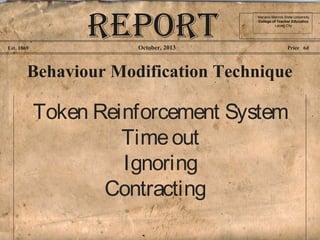
Behavior modification technique (micko joshua cabel)
- 1. October, 2013Est. 1869 Price 6d Behaviour Modification Technique . Mariano Marcos State University College of Teacher Education Laoag City REPORT Token Reinforcement System Timeout Ignoring Contracting
- 2. Reinforcement is the most important principle of behavior and a key element of most behavior change programs. It is the process by which behavior is strengthened, if a behavior is followed closely in time by a stimulus and this results in an increase in the future frequency of that behavior. The addition of a stimulus following an event that serves as a reinforcer is termed positive reinforcement. If the removal of an event serves as a reinforcer, this is termed negative reinforcement. There are multiple schedules of reinforcement that affect the future probability of behavior. Token Reinforcement System
- 3. • In most cases reinforcement refers to an enhancement of behavior but this term may also refer to an enhancement of memory. One example of this effect is called post- training reinforcement where a stimulus (e.g. food) given shortly after a training session enhances the learninga
- 5. Example of Token Economy
- 6. Time out It is a US term for a form of punishment that involves temporarily separating a child from an environment where inappropriate behavior has occurred, and is intended to decrease positive reinforcement of the behavior.
- 7. • It is an educational and parenting technique recommended by some pediatricians and developmental psychologists as an effective form of child discipline. Often a corner (hence the common term corner time) or a similar space where the child is to stand or sit during time-outs is designated.
- 8. • The use of time-out as an acceptable therapeutic procedure has gained wide acceptance in schools, clinics, and hospitals. The purpose is to isolate or separate the child for a short period of time (usually 5 to 15 minutes) in order to allow the child to calm down, as well as to discourage inappropriate behavior.
- 9. • To be most effective, parents should evaluate each situation to determine what may be causing the misbehavior, such as a toy, frustration, hunger, or lack of sleep. Parents should also explain why the child was put there, in order to make it an opportunity for learning, and how long he needs to stay there (but too much explanation can reinforce the unwanted behavior [5] ). • In some views, the only requirement for release is for the child to be sitting peacefully, while others advocate a set period of time. When the child has calmed down, they may then express their needs in a more polite manner or return to their activity.
- 10. Ignoring • to refrain from noticing or recognizing • Ignoring can be a valuable tool in reducing misbehaviors when used with behavior- building strategies. However, it's difficult for many of us to determine which behaviors to ignore and which to give attention. We tend to take ignoring to extremes by ignoring almost all misbehaviors or none at all. Neither approach is effective.
- 11. Instead: Ignore Wisely • First, not all behaviors should be ignored. We should only ignore the behaviors motivated for our attention.
- 12. For example: • For example, if Larry is playing his favorite computer game instead of doing math, ignoring him will not work because his behavior is not motivated by our attention. His motivation is playing on the computer. • However, when behaviors are attention seeking we need to ignore continuously (every single time). As soon as we begin to ignore our student's misbehavior, he or she will seek it elsewhere, most likely from peers.
- 13. • It can be difficult for peers to ignore misbehaviors. Therefore, ignoring misbehavior should be a classroom rule that receives powerful reinforcement. Also, we need to plan for the misbehavior to get worse (happen more often and more intensely) before it improves. When this happens, we must continue to ignore.
- 14. • Ignoring must be used in combination with behavior- building strategies, such as reinforcement of appropriate behaviors, teaching replacement behaviors, and reinforcing peers. Ignoring teaches students what not to do, but does not teach them what they should do instead. For example, a preschool student, Monica, has a tendency to tug at our clothing or yell to get our attention. In this scenario, we should ignore these misbehaviors. In addition, we need to teach Monica appropriate ways to gain our attention (e.g., raising her hand, saying "excuse me") and praise her each time she uses these replacement behaviors. To add to the effectiveness, we could also praise peers who, in her presence, appropriately seek our attention.
- 15. • There are occasions when ignoring is inappropriate. These include when there are concerns for observational learning of misbehaviors, when our students are engaging in extreme or dangerous behaviors, and, as stated earlier, when the misbehavior is not attention seeking.
- 16. Contracting • It is a convention between a teacher and a child. • once the child followed the contract, the teacher should able to give a reward to the child ( e.g material thing, grading system etc.)
- 17. October, 2013Est. 1869 Price 6d Behaviour Modification Technique TOKENREINFORCEMENTTIMEOUTCONTRACTINGIGNORING . Mariano Marcos State University College of Teacher Education Laoag City REPORT MICKO CABEL Repo rter
